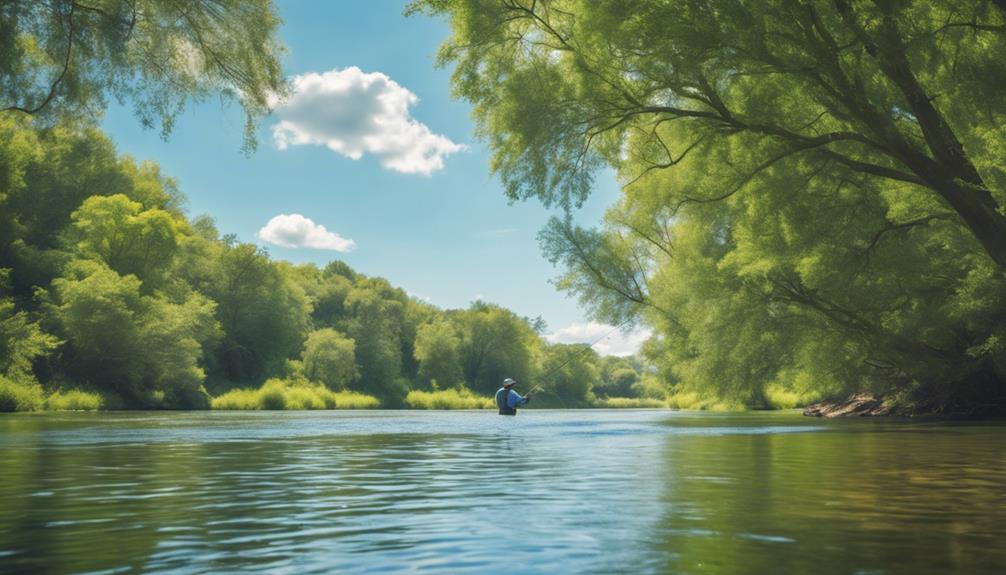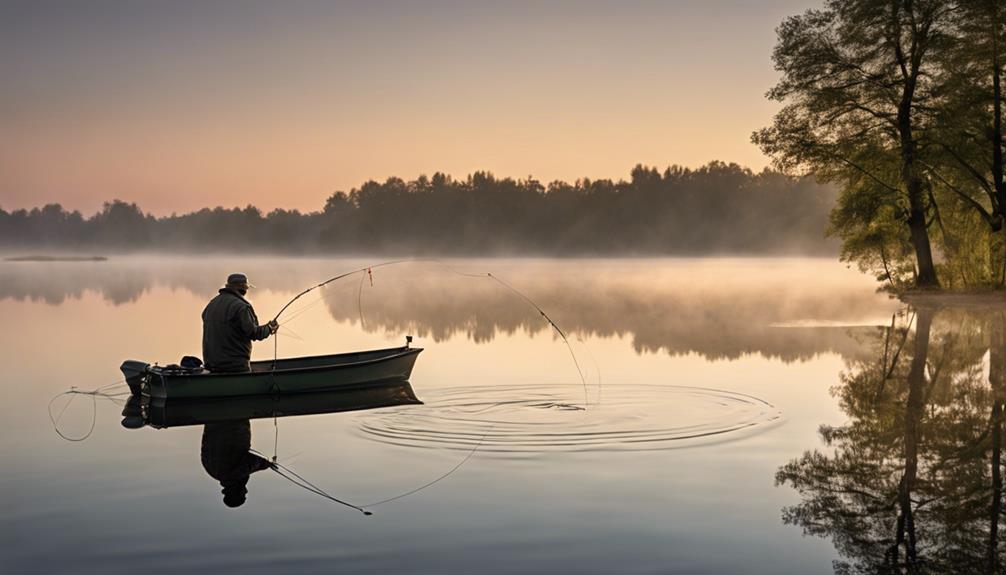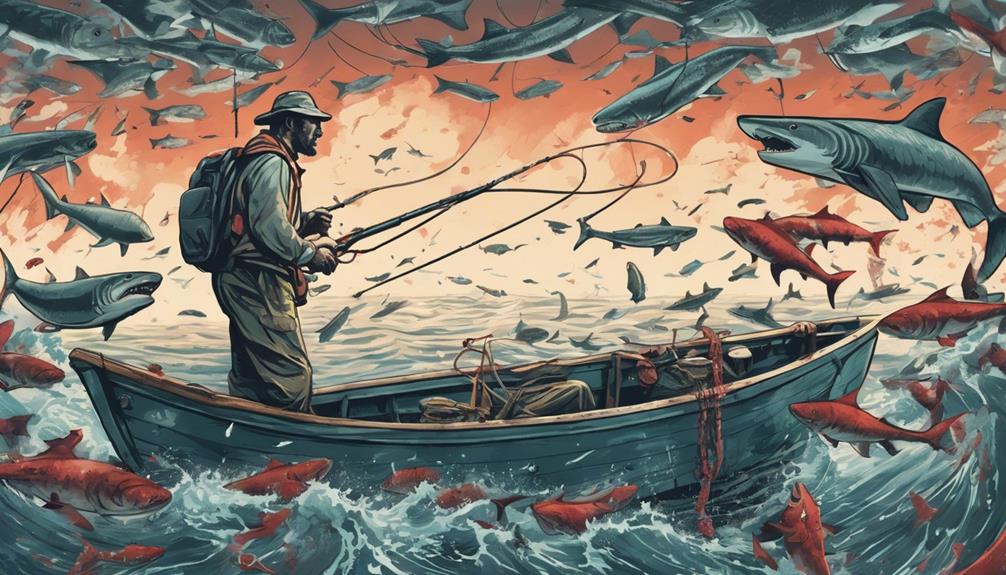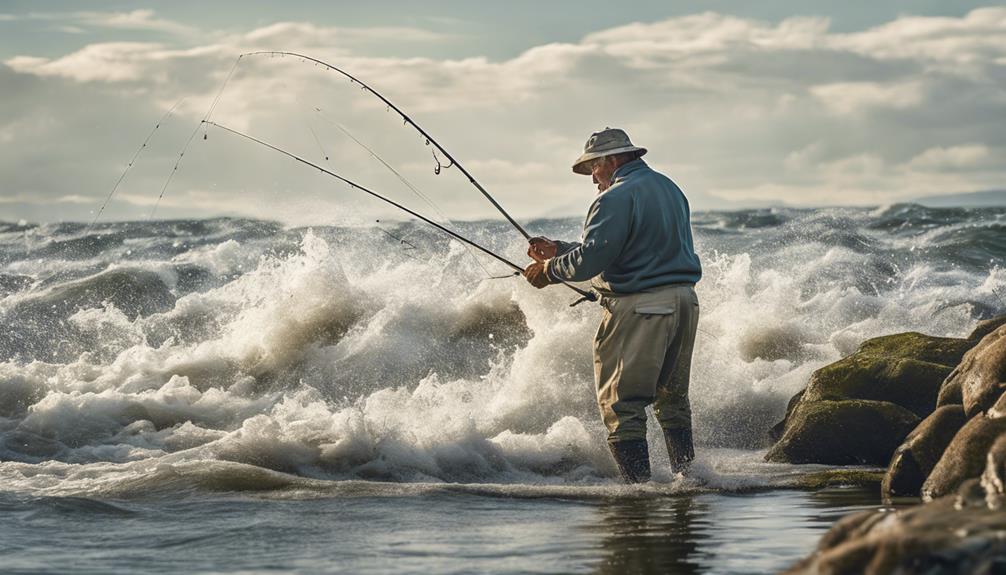Embarking on the journey of mastering fly fishing techniques is akin to navigating a river full of twists and turns, each bend revealing new challenges and triumphs.
As a novice angler, you stand at the water's edge, eager to cast your line and reel in your first catch. But how do you ensure a successful outing and make the most of your time on the water?
Let's uncover the essential techniques that will set you on the path to becoming a skilled fly fisher.
Understanding Fly Fishing Basics
To begin with, grasp the essential principles of fly fishing to lay a strong foundation for your angling journey. Fly fishing involves a unique method of casting where the weight of the line propels the lightweight fly forward. One crucial aspect of fly fishing is fly tying, where you create artificial flies to mimic natural insect prey. Learning this skill allows you to customize your flies to match the specific insects present in the waters you're fishing.
Understanding stream etiquette is also vital. When fishing in streams, it's essential to be mindful of other anglers. Give them space and respect their fishing areas. Avoid cutting through the water where others are fishing, as this can disturb the fish and disrupt their feeding patterns. Additionally, be aware of how your movements and shadows can spook fish, making them less likely to bite.
Developing good stream etiquette not only enhances your fishing experience but also contributes to a harmonious environment for all anglers. By mastering the art of fly tying and adhering to stream etiquette, you set yourself on the right path towards becoming a skilled fly angler. These foundational aspects of fly fishing won't only improve your technique but also deepen your appreciation for the sport.
Selecting the Right Equipment
Mastering fly fishing techniques starts with selecting the right equipment that suits your angling style and preferences. When it comes to equipment maintenance and gear storage, remember to clean your gear after each use to prevent rust and damage. Properly store your fly rods, reels, lines, and flies in a dry and cool place to prolong their lifespan and ensure they perform optimally when you head out for your next fishing adventure.
Rod selection is crucial in fly fishing. Consider factors like the type of fish you're targeting, the size of the water you'll be fishing in, and your casting ability. A 9-foot, 5-weight rod is a versatile choice for beginners as it can handle various fishing conditions and fish species. As for reel options, choose a reel that balances well with your rod and has a smooth drag system. A large arbor reel allows for quicker line retrieval, while a mid-arbor reel offers a balance between line capacity and retrieval speed.
When selecting equipment, prioritize quality over quantity. Invest in a few essential pieces of gear that are durable and suited to your needs rather than buying a large collection of lower-quality items. By choosing the right equipment and maintaining it properly, you set yourself up for success on the water.
Mastering the Cast
Developing a smooth and accurate casting technique is essential for success in fly fishing. When it comes to casting accuracy, timing is everything. To achieve precision in your casts, focus on the timing of your movements. Make sure to accelerate smoothly on the forward and backward casts, releasing the line at the right moment to propel the fly accurately towards your target.
Line control plays a crucial role in fly fishing. Proper line management allows for better presentation of the fly to the fish. Avoid slack in the line by maintaining tension throughout the cast. Remember, a drag-free drift is key to enticing fish to strike. Practice mending the line to adjust the fly's drift and avoid unnatural movement that may spook the fish.
For a successful presentation, work on your casting accuracy and line control simultaneously. Aim to deliver the fly gently onto the water, mimicking the natural movement of insects. Keep an eye on your fly and be ready to set the hook at the slightest sign of a strike. Mastering the cast takes time and practice, so don't get discouraged by initial challenges. With patience and persistence, you'll soon find yourself casting with precision and presenting your fly like a seasoned angler.
Identifying Fly Patterns
Understanding different fly patterns is crucial for effectively enticing fish while fly fishing. Matching the hatch is a fundamental concept in fly fishing. It involves selecting a fly pattern that closely resembles the insects or baitfish present in the water at that time. By observing the insects around you or checking under rocks near the river, you can determine the prevalent species and choose a fly that mimics them. This increases the chances of the fish taking your fly since it appears natural to them.
Fly presentation is another key aspect when identifying fly patterns. Even if you have the perfect fly pattern, if it's not presented well, the fish may not be interested. Pay attention to how the insects move on the water's surface or below it and try to imitate that movement with your fly. This can involve using techniques like dead drifting, twitching, or skating the fly across the water to make it look enticing to the fish.
Learning to Mend the Line
To improve your fly fishing technique, mastering the skill of mending the line is essential. Line control plays a crucial role in fly fishing, especially when it comes to drag reduction. By mending the line effectively, you can adjust the position of your fly on the water, ensuring a natural drift that can attract more fish.
Loop formation is another key aspect of line management. When mending the line, focus on creating smooth loops to avoid disturbing the fly. This will help in maintaining a drag-free presentation, increasing your chances of a successful catch. As you gain more experience, you'll learn to mend the line in different water types, such as slow-moving rivers or fast-flowing streams.
Practice is vital when learning to mend the line. Start by understanding the current and how it affects your line. Experiment with different mending techniques to see which works best for you. Remember, the goal is to achieve a seamless drift that mimics natural insect movement.
As you become more proficient in mending the line, you'll notice an improvement in your overall fly fishing performance. Your ability to control the line and reduce drag will result in more accurate presentations and increased strikes. So, keep practicing and honing your skills to become a successful fly angler.
Navigating Different Water Types
Navigating different water types requires adaptability and a keen understanding of how each environment influences your fly fishing approach. When faced with swift currents in rivers, it's crucial to position yourself strategically. Look for slower-moving pockets along the edges where fish may be hiding from the strong flow. Utilize river strategies such as casting upstream and letting your fly drift naturally towards the fish. Adjust your casting angle and mending techniques to account for the speed of the current.
Conversely, when fishing in calm pools of lakes, focus on precision casting. Lake techniques often involve presenting your fly gently on the water's surface to mimic natural insect behavior. Pay attention to any signs of fish activity, like rising bubbles or ripples, and target those areas. Experiment with different retrieval speeds to see what entices the fish to strike.
Setting the Hook Properly
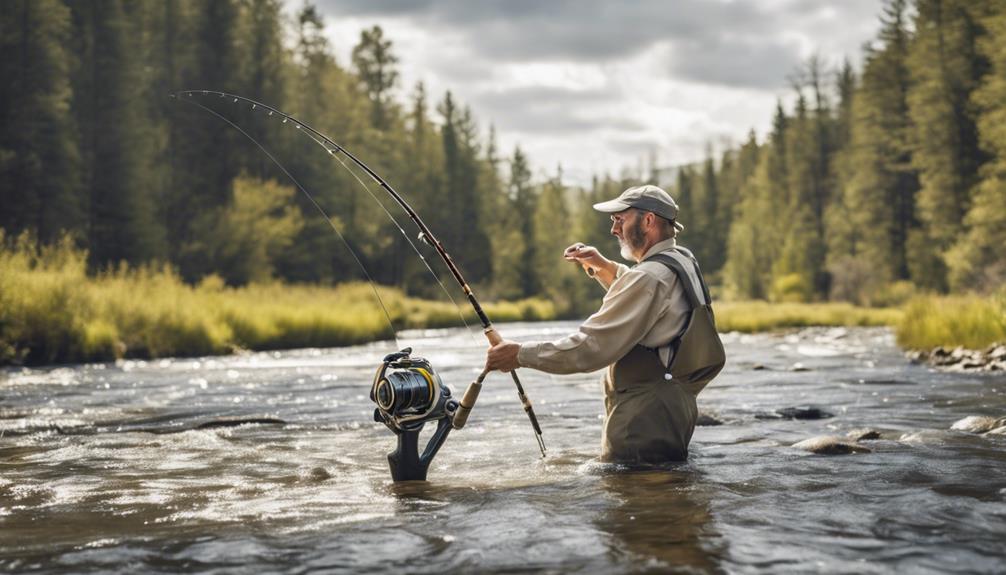
When setting the hook properly in fly fishing, ensure a swift and decisive motion to secure a solid connection with the fish. Proper technique is crucial for hooking success, so follow these tips to improve your chances:
- Keep a firm grip on the fly rod and stay alert for any signs of a fish taking the fly.
- As soon as you feel a tug or see a fish strike, swiftly raise the rod tip while simultaneously stripping the line.
- Remember to set the hook with enough force to penetrate the fish's mouth but not too hard to break the tippet.
- Maintain tension on the line to keep the hook securely embedded in the fish's mouth during the fight.
- Practice setting the hook at different angles and depths to adapt to varying fishing conditions and fish behavior.
Practicing Catch and Release Ethics
Practicing proper catch and release ethics ensures the preservation of fish populations and the sustainability of fly fishing for future generations. To effectively practice catch and release, there are key conservation tips and proper handling techniques you should follow. When catching a fish, it's crucial to minimize its time out of the water. Keep the fish submerged as much as possible, even when removing the hook. Avoid using a net with knotted mesh that can damage the fish's slime layer. Instead, opt for a rubber-coated net or wet your hands before handling the fish to prevent removing its protective coating.
When releasing the fish, support it underwater until it's able to swim away on its own. Avoid tossing the fish back into the water or letting it go before it has regained its strength. If the fish appears exhausted, gently move it back and forth in the water to facilitate oxygen flow over its gills. Additionally, avoid squeezing the fish tightly or holding it vertically by its jaw, as this can injure internal organs.
Frequently Asked Questions
How Can I Prevent My Fly Line From Tangling While Casting?
To prevent your fly line from tangling while casting, focus on line management and tension control. Maintain proper tension throughout your cast, especially during the backcast. Avoid slack in the line by keeping it taut.
Pay attention to your casting technique and ensure smooth movements to minimize tangles. Practice regularly to improve your skills in managing the line effectively while casting.
What Are Some Common Mistakes Beginners Make When Choosing a Fly Pattern?
When choosing a fly pattern, beginners often make mistakes by not considering proper presentation and matching the hatch. It's crucial to select a fly that mimics the insects the fish are feeding on. Avoid the error of using the wrong size or color.
Focus on observing the water and understanding the behavior of the fish to make an informed choice. By paying attention to these details, you'll improve your chances of a successful catch.
How Do I Properly Clean and Maintain My Fly Fishing Equipment?
To properly clean and maintain your fly fishing equipment, remember these key steps.
Store your gear in a dry, cool place to prevent damage. Create a maintenance schedule for your reels, rods, and lines. Regularly clean and lubricate your reels to keep them in top condition. Check your rods for any signs of wear and tear, and replace any damaged parts promptly.
Are There Any Specific Techniques for Fishing in Windy Conditions?
When fishing in windy weather, casting can be a challenge. To prevent your fly line from tangling, focus on your casting technique. Try making shorter, more controlled casts to maintain accuracy.
Utilize the wind to your advantage by casting with the wind direction. Keep your line tight to prevent it from getting blown off course.
Practice casting in different wind conditions to improve your skills and adaptability on the water.
Can You Recommend Any Resources for Further Improving My Fly Fishing Skills Beyond the Basics?
When looking to enhance your fly fishing skills, consider exploring resources like advanced casting techniques and fly tying tutorials. These can take your abilities to the next level beyond the basics.
Conclusion
Now that you've learned the basics of fly fishing techniques, it's time to hit the water and put your skills to the test.
Remember to practice patience and persistence as you continue to hone your craft. With the right equipment and knowledge, you'll soon be reeling in those big catches like a pro.
Keep practicing and exploring new techniques to become a successful fly angler.
Happy fishing!
